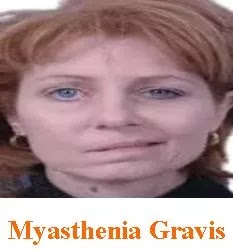'Myasthenia Gravis' is a disease characterized by abnormal fatigability of certain muscle groups, with incapacity to sustained muscular activity.
Pathology
The basic pathology is the formation of antibodies against acetylcholine receptors at the neuromuscular junction, which leads to inhibition of neuromuscular transmission of nerve impulses to muscles. This results in weakness fatigue etc. and forms myasthenia gravis.
Etiology / Causation
Age: 2nd and 3rd decades.
Sex: Both sexes - females are more affected.
It May e associated with thyrotoxicosis, carcinoma, rheumatoid arthritis, pernicious anemia, etc.
Symptoms / Signs
Abnormal fatigability of skeletal muscles.
The most often affected muscles are the bulbar, extraocular, neck, and shoulder girdle muscle.
The earlier symptom is ptosis and diplopia.
Tiredness during chewing, swallowing, speaking, etc.
Relapses are common during emotional upsets, severe muscular exercises, etc.
Paralysis of respiratory muscles may lead to asphyxia and death.
How to diagnose?
Ask the patient to look upwards continuously, gradually the upper eyelid will droop down.
Injection Neostigmine 1.5 mg intramuscularly will give quick relief to fatigue.
EMG - Classical decremental pattern. Serological testing for antibodies against acetylcholine receptors.
Differential diagnosis
Hysteria
Disseminated sclerosis
Polymyositis
Motor neuron disease
Muscular dystrophy
Treatment
Avoid fatigue, exercise.
Artificial respiration, if required.
Prevent infections.
The patient is always happy in myasthenia gravis.
Homeopathic medicines
Anacardium ori, Arsenicum album, Kali carb, Phosphorus, Rhus tox.


Post a Comment